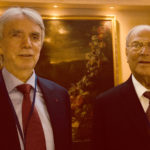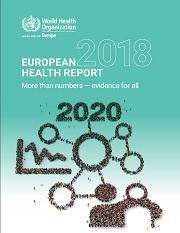Preventing and dealing with age-related macular degeneration (AMD): a meeting devoted to the leading cause of blindness in industrialized countries
Organized by Novartis, the meeting aimed to take stock of the prevention and treatment of AMD. IAPB Italy, the Italian Society of Ophthalmology and the University of Rome Torvergata were present at the event.
Wet (or exudative) AMD – a chronic and degenerative disease that gradually damages the retina – is the main common cause of severe vision impairment and blindness in people aged over 65, affecting an estimated 20-25 million people all over the world. According to WHO’s estimates, this number is destined to grow, due to both the current state of patients and the increase in life expectancy.
Being affected by AMD can be a tragic and distressing experience, as recounted by a patient at the event. A professional painter, she experienced total central vision loss in the left eye early in 2000, when drug development had not yet reached today’s level. The outcome was different when, ten years later, after experiencing the same symptoms in the right eye – “a strong blow inside the eye” – she rushed to the hospital and received a timely treatment. After a few sessions, the eye was healed.
The lesson to be learned from this experience is that what matters is not only the pharmacopoeia, but also individual behaviour. Being examined for an early diagnosis is up to patients. And being examined before the onset of any symptoms is crucial.
“The importance of eye health is underestimated – said Mr. Tiziano Melchiorre, Secretary-General of IAPB Italy – and so are chronic and degenerative eye diseases, which lead to blindness, and their social burden, which includes reduced mobility and personal autonomy, an increased risk of accidents and the rise in the number of cases of depression. It is mandatory to keep people informed, speed up the diagnostic process and promote access to treatment, in order to prevent blindness and contain as much as possible the tragic consequences of visual impairment. Furthermore, it is important to increase awareness among patients and their families about the progression of diseases such as AMD, reminding them about the importance of following the prescribed treatments with consistency and promoting access to vision rehabilitation services.”
Dr. Marco Piovella, president of the Italian Society of Ophthalmology (SOI) has stressed that, “AMD has to be diagnosed as early as possible, since it is not curable. Timely therapeutic strategies include the monitoring of pathological fluid, so to prevent healthy photoreceptors from being damaged and contain vision loss. When treatments are successful, we speak of disease ‘control’ and patients need to be accurately informed about the risks of disease progression, also increasing their awareness about the importance of being consistent in following treatments over time. In Italy, 70% of the population is not treated or treated only partially, which nullifies therapeutic results. There are several reasons why this happens, some of them of a social nature – such as insufficient patient awareness of the disease – and others, which are more related to the structural and managerial limits of the national health system – such as excessive bureaucracy and limited finances.”
“It is important to treat not just symptoms, but also the underlying cause of the illness. In AMD, damage to the retina is due to retinal fluid leaking out of abnormal blood vessels in the back of the eye – said Prof. Federico Ricci, Director of the Chronic and Degenerative Eye Disease Department at the University of Rome Torvergata. In an ophthalmologist’s therapeutic arsenal, there are several classes and generations of drugs: some were synthesized more than ten years ago, others are molecules which have been recently developed. New drugs have a superior control ability over the retinal fluid than first generation drugs, and need to be injected less frequently to keep the retina dry. This is the case of Brolucizumab, a humanized single-chain antibody fragment of small dimensions, which is characterized by an excellent tissue penetration profile and high capacity to eliminate the liquid from the retina, thus keeping the retinal tissue in optimal operating condition. Brolucizumab is the only anti VEGF to have proven its efficacy in pivotal trials for eligible patients, with a three-month treatment interval immediately following the initial three monthly loading doses, in about 50% of cases. The drug was in fact recently approved by the FDA with this posology, called a fixed regimen, which also allows a precise planning of therapy over time “.










































 “The Eye of the Mind” is the title of the Conference on vision rehabilitation that was held on 23rd November, 2018, at the George Eastman Dental Hospital in Viale Regina Elena 287, Rome. The meeting continued on the following day at the Ophthalmology Clinic of the Umberto I Polyclinic Hospital.
The first day was dedicated, in particular, to neuro-ophthalmological issues in children and adults (including brain plasticity), while presentations on the second day focused more on technical-rehabilitative aspects, and on the protocols (rehabilitation procedures) and the assessment of vision disabilities. (
“The Eye of the Mind” is the title of the Conference on vision rehabilitation that was held on 23rd November, 2018, at the George Eastman Dental Hospital in Viale Regina Elena 287, Rome. The meeting continued on the following day at the Ophthalmology Clinic of the Umberto I Polyclinic Hospital.
The first day was dedicated, in particular, to neuro-ophthalmological issues in children and adults (including brain plasticity), while presentations on the second day focused more on technical-rehabilitative aspects, and on the protocols (rehabilitation procedures) and the assessment of vision disabilities. (












 Stop smoking, it could “cloud” your health. Despite the written warning on cigarette packets in Italy that “smoking increases the risk of blindness”, Italian teenagers seem to turn a blind eye, so to speak, to this kind of cautionary advice. In a meeting held in Rome from 17th to 20th September 2018, which was opened by the Italian Prime Minister, Giuseppe Conte, WHO Europe presented an alarming
Stop smoking, it could “cloud” your health. Despite the written warning on cigarette packets in Italy that “smoking increases the risk of blindness”, Italian teenagers seem to turn a blind eye, so to speak, to this kind of cautionary advice. In a meeting held in Rome from 17th to 20th September 2018, which was opened by the Italian Prime Minister, Giuseppe Conte, WHO Europe presented an alarming 




